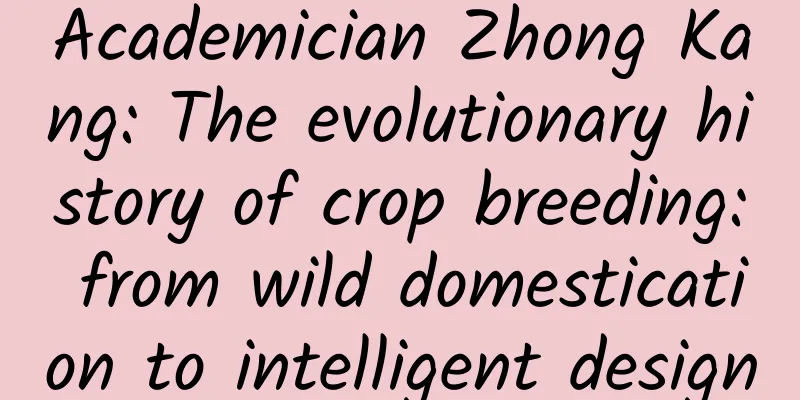Academician Zhong Kang: The evolutionary history of crop breeding: from wild domestication to intelligent design

|
Editor's note: General Secretary Xi Jinping pointed out that "popularizing science is an important basic work for achieving innovative development." In order to help high-level scientific and technological self-reliance, the Science Popularization Department of the China Association for Science and Technology and Guangming Online jointly launched the "Academician High-end Science Popularization" column, inviting academicians from various fields to give authoritative answers to current hot scientific and technological issues in my country, serving to guide more scientific and technological workers to improve their scientific research and popularization capabilities, promote the improvement of the scientific literacy of the whole people, and contribute to the popularization of science for the construction of a strong country in science and technology. #千万IP创科普 Plants are the main providers of human food. Although there are about 30,000 edible plants in the world, humans only use 30 of them to feed the world. Among them, five types of grains, rice, wheat, corn, sorghum and millets (such as millet and sorghum), provide 60% of the total energy for the global population; 10 crops provide 95% of the food consumed by humans and domestic animals. How can we efficiently utilize the species provided by nature? From primitive society to agricultural society, and then to modern society, the utilization of plant resources in nature is different in different eras. In primitive society, we directly collected and ate whatever species resources were available in nature. In agricultural society, humans began to domesticate species. For example, cultivated rice is domesticated from wild rice. Wild rice has strong grain shedding, long awns, hard shells, and difficulty in molting, which are not conducive to human use. After tens of thousands of years of domestication and selection, cultivated rice has large grains, shorter or even no awns, and high yields. The process of transforming wild plants into cultivated crops is called domestication and breeding. After becoming cultivated crops, some varieties are formed, which are called "farmer varieties". In the era when there was a lack of knowledge of biological genetics, the domestication and breeding of wild plants relied entirely on experience, which belongs to the breeding 1.0 era. Since the 19th century, the development of life sciences has driven the continuous upgrading of breeding technology. In the early 20th century, genetic theory was developed, and scientists began to explore the mysteries of heredity and variation. The most typical breeding technology is hybridization technology, such as hybrid corn in the 1930s. Until now, some crops are still mainly cultivated through genetic hybridization. The application of this genetic breeding technology is called breeding 2.0. Its disadvantages are low efficiency. It generally takes more than 10 years to cultivate new varieties, and it is difficult to select breakthrough varieties. After the development of molecular biology, scientists began to know that breeding is actually controlled by genes. Genes determine what an organism looks like and what characteristics it has, and can also pass these appearances and characteristics to its offspring. Therefore, some molecular biological technologies, such as transgenic technology, have been applied to the field of breeding, that is, using a certain gene or certain gene fragments as auxiliary breeding. We call this the era of molecular breeding 3.0. Molecular breeding based on molecular biology has greatly improved the level and efficiency of breeding. Molecular biology technology can quickly determine "which genes are positively controlling crop traits, which genes are negatively controlling, and the network relationships between them". Scientists use transgenic technology and gene editing to quickly "domesticate" wild varieties into new varieties that can meet modern human needs in just a few years. Although many of our crops are still in the breeding 2.0 and 3.0 stages, after entering the 21st century, genome editing technology has pushed crop breeding to the 4.0 stage - design breeding, that is, based on gene modules and their nonlinear coupling theory, as well as synthetic biology ideas, with the help of computational biology and artificial intelligence to design ideal varieties, greatly shortening the breeding cycle and improving breeding efficiency. For example, now we can design what we want rice crops to look like. Because each of the traits we need is determined by the state of a certain gene, these genes are organically integrated to achieve all the traits we need in one plant at the same time. This crop is the variety we want. At present, my country's rice breeding is at the leading level internationally, and it has been able to use genomics and systems biology to design varieties. At present, the country advocates a "big food concept", which not only includes staple food, but also the vegetables and fruits we eat, the tea we drink, etc. These crop improvements are inseparable from our plant scientists. Plant scientists use modern biological technology to promote the rapid development of breeding technology, which not only enriches the types of crops, but also creatively improves the nutritional content of crops, providing strong support for ensuring food security and the stable supply of important agricultural products. With the rapid development of computational biology and synthetic biology technologies, design breeding will become a new trend in future competition and will further develop towards intelligence and precision. To this end, scientists should actively explore new phenomena, reveal new mechanisms, build new carriers, develop new technologies, and establish new research systems to comprehensively promote the development of plant science and contribute to food security and the concept of big food. (The article was shared by Zhong Kang, an academician of the Chinese Academy of Sciences, at the "Chinese Society of Cell Biology Popular Science Master Campus Tour" event, compiled by Guangming Online reporters Xiao Chunfang and Wu Yuetong) |
Recommend
Why is the ad ranked third on the left in Baidu promotion live broadcast, but ranked last on the right when I search on my computer?
First, you should check whether the live promotio...
Pluto: No Longer a Planet Controversy
The question of whether Pluto has lost its planet...
How to write a planning proposal? The process and skills of operating promotion plan
For marketers, making marketing plans is a common...
Answers to 7 questions about Toutiao information flow delivery!
This article organizes and shares some of the pro...
36 Strategies of Sales Closing eBook
36 Strategies of Sales Closing eBook The first se...
National weather map for National Day released: cool rain in the north means autumn is here, hot summer in the south
After years of anticipation, the National Day hol...
The creator of Android announced his resignation and is willing to provide opportunities for more companies
Beijing time, October 31 morning news, Google ann...
Query the price of joining Zhangbei Luggage Mini Program. How much is the price of joining Zhangbei Luggage Mini Program?
For entrepreneurs, although mini program developm...
Why does Apple want to punish Tencent? Written after the 5.5 earthquake at the Apple Store!
The App Store earthquake came and went quickly, j...
If you want to run a successful e-commerce event, start with these aspects!
So far, the author has been working in the fresh f...
Essential for contacting Apple! The most complete official contact information of App Store! Updated July 2017
The main contact methods currently published by A...
The fastest way to earn $500,000 a month? Apple App Store becomes a hotbed for scam software
Recently, foreign technology writer Johnny Lin pu...
How do astronauts know what time it is? Don't worry, they have "space watches"!
On Earth, we are used to working at sunrise and r...
[Popular Science of Chinese Military Technology] As the "King of Rolls" among cruise missiles, what are the outstanding features of the Haiyan nuclear-powered cruise missile?
Recently, according to Russian media reports, the...
"Life-extending magic weapon" may also be a "weapon of harm"? These 9 types of people should drink less coffee!
For modern people, coffee has gradually become a ...









